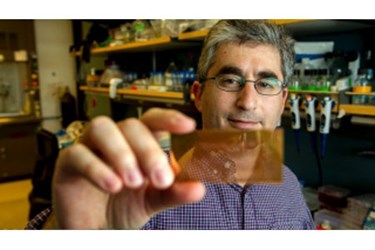Plasmonic, Microchip-Based Test Could Improve Diabetes Diagnosis
By Joel Lindsey

Researchers at the Stanford University School of Medicine have created a new microchip that uses nanotechnology to diagnose type-1 diabetes.
“With the new test, not only do we anticipate being able to diagnose diabetes more efficiently and more broadly, we will also understand diabetes better — both the natural history and how new therapies impact the body,” Brian Feldman, assistant professor of pediatric endocrinology at Stanford and senior author of the paper, said in a press release issued recently.
Feldman and other researchers said that the new handheld microchip-based test could represent a significant improvement over traditional diabetes tests, making it easier and cheaper to diagnose type-1 diabetes.
The new device uses a fluorescence-enhancing technique that enables the reliable identification of the auto-antibodies associated with type-1 diabetes. Each microchip includes a specialized glass plate with an array of nanoparticle-sized gold droplets arranged on the surface. The gold intensifies the fluorescent signals of the auto-antibodies, enabling for easier detection and diagnosis, according to the press release.
“The auto-antibodies truly are a crystal ball,” said Feldman. “Even if you don’t have diabetes yet, if you have one auto-antibody linked to diabetes in your blood, you are at significant risk; with multiple auto-antibodies, it’s more than 90 percent risk.”
In early studies of the new device, researchers tested blood samples both from people who had been recently diagnosed with diabetes and people without diabetes. Both groups had their blood tested by traditional lab tests as well as the new microchip-based device in order to compare the accuracy and reliability of the new device.
According to researchers involved with the project, the new device requires only a drop of blood from a finger prick instead of a lab-based blood draw. It can also be used with minimal training and could generate results in just a few minutes. Additionally, the microchip could be produced for around $20, and a single chip could be used to run approximately 15 tests.
All of this could translate to more accessible diabetes testing, which could be especially helpful in places where lab-based tests are too expensive or too difficult to access.
“There is great potential to capture people before they develop the disease, and prevent diabetes or prevent its complications by starting therapy early. But the old test was prohibitive for that type of thinking because it was so costly and time-consuming,” said Feldman. “We would like this to be a technology that satisfies global need.”
Details regarding the new device and its performance in initial tests have been published in the journal Nature Medicine. Researchers have filed for a patent for the microchip and are currently working to obtain FDA approval of the device.
Image credit: Norbert von der Groeben
